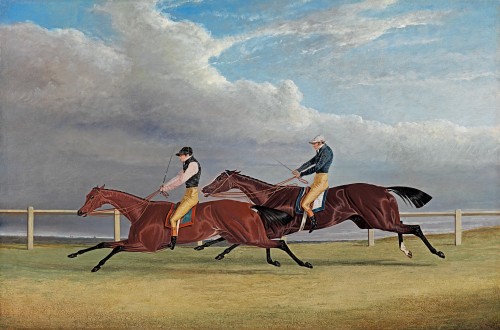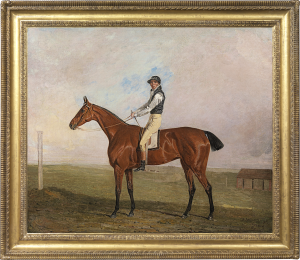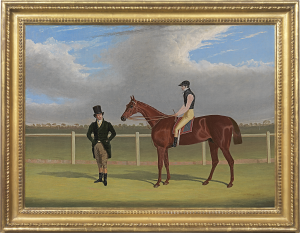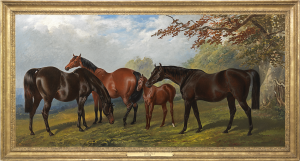John Frederick Herring Snr
Matilda and Mameluke: the finish of the 1827 St Leger
Oil on canvas: 24 x 36 (in) / 61 x 91.4 (cm)
Signed and dated centre left: J.F. Herring 1827
This artwork is for sale.
Please contact us on: +44 (0)20 7493 3939.
Email us
JOHN FREDERICK HERRING SNR
Surrey 1795 - 1865 Meopham Park, Kent
Ref: CB 193
Matilda and Mameluke: the finish of the 1827 St Leger
Signed and dated centre left: J.F. Herring 1827
Oil on canvas: 24 x 36 in / 61 x 91.4 cm
Frame size: 31 ½ x 42 ½ in / 80 x 108 cm
Provenance:
Arthur Ackermann & Sons Ltd, London, by 24th June 1942;
from whom acquired by AS Clark on 21st May 1948
Sir Alfred Chester Beatty (1875–1968);
his son Alfred Chester Beatty (1907–1983), Owley, Wittersham, Kent;
by descent;
Sotheby’s London, 8th December 2016, lot 200;
Richard Green, London;
private collector, UK
The 1827 St Leger was particularly famous as a duel in the long-running battle between the North of England (here represented by Matilda) and the South (represented by Mameluke). ‘A handsomer little filly than Matilda, and a finer and more slashing colt than Mameluke, never met together on any race-course’ (Thomas Henry Taunton, Portraits of Celebrated Racehorses, vol. II, London 1887, p.289). Matilda was bred by the Hon. Edward Petre of Stapleton Park, Yorkshire, scion of an old Catholic family who also owned Ingatestone Hall in Essex. He eventually bankrupted himself through his enthusiasm for the Turf, but not before chalking up many winners. Matilda was by Comus out of Juliana. Her jockey, James Robinson, rode her without spurs, as Herring shows in the present painting.
Matilda’s adversary Mameluke, by Partisan out of Miss Sophia, was bred by Mr Elwes. He was sold to the Earl of Jersey, for whom he won the 1827 Derby with Robinson up. He was then sold to Mr John Gully, the famous ex-prizefighter, for the huge sum of 4,000 gns, and ridden by Sam Chifney in the 1827 St Leger.
Matilda’s odds were 10-1, while the much larger Mameluke was the favourite at 5-2. He was unsettled by a series of fiendishly engineered false starts and eventually started at 100-30, to much muttering from the crowd, ‘as the jealousy of a south-country horse winning the St Leger is too well-known to be enlarged upon’ (Taunton, op. cit., p.283). Normally even tempered, Mameluke became almost unmanageable and Chifney had great difficulty getting him to the Post. Matilda shot away and was on the top of the hill before Mameluke was half-way. Mameluke staged a magnificent comeback, but Matilda won by half a length, preserving the honour of the North. John Gully, who backed his horse heavily, is said to have lost £40,000 from Mameluke’s failure.
Matilda was in fact Petre’s second string as he also owned Granby (who started as favourite after the false starts), ridden by Will Scott and trained by John Scott. Herring shows Matilda carrying Petre’s normal colours of black and pink, although in the actual race she carried black, white sleeves, white cap. Herring painted several portraits of Petre’s gallant little filly, including one in the collection of the Jockey Club.
JOHN FREDERICK HERRING, Senior
Surrey 1795 - 1865 Meopham Park, Kent
John Frederick Herring was the son of a London merchant of Dutch parentage, who had been born in America. The first eighteen years of his life were spent in London, where his greatest interests were drawing and horses. In 1814 he moved to Doncaster, arriving just in time to see the Duke of Hamilton's `William' win the St. Leger. By 1815 he had married Ann Harris; his sons John Frederick Herring Junior, Charles and Benjamin were all to become artists, while his daughters Ann and Emma both married painters.
In Doncaster, Herring earned his living as a painter of coach insignia and inn signs and his contact with a firm owned by a Mr Wood led to his subsequent employment as a night coach driver. His spare time was spent painting portraits of horses for inn parlours and he became known as the `artist coachman'. Herring's talent was quickly recognised and he soon found himself painting hunters and racehorses for the gentry.
In 1830, Herring left Doncaster for Newmarket, where he spent three years before moving to London. During this time, he may have received tuition from Abraham Cooper. In London, Herring got into financial difficulties and was rescued by W T Copeland, who commissioned many paintings including designs used for Copeland Spode bone china. In 1840-41, Herring visited Paris by invitation of the Duc d'Orleans, for whom he painted several pictures. In 1845, Herring was appointed Animal Painter to HRH the Duchess of Kent, followed by a commission from Queen Victoria, who was to remain a patron for the rest of his life.
Herring spent the last twelve years of his life at Meopham Park near Tonbridge, where he lived as a country squire. He now broadened his subject matter and painted agricultural scenes and narrative pictures, as well as his better known works of hunting, racing and shooting. A highly successful and prolific artist, Herring ranks with Sir Edwin Landseer as one of the most eminent animal painters of the mid nineteenth century. His paintings were very popular and many were engraved, including his thirty-three winners of the St Leger and his twenty-one winners of the Derby. Herring exhibited at the Royal Academy 1818-65, the British Institution 1830-65 and the Society of British Artists (whose Vice-President he became in 1842), 1836-52.



























